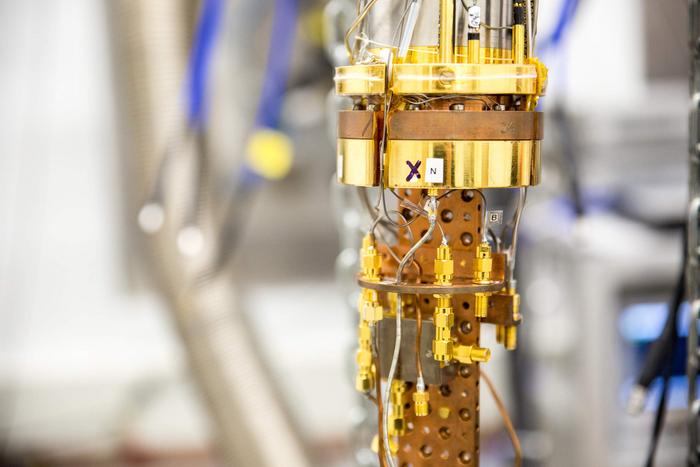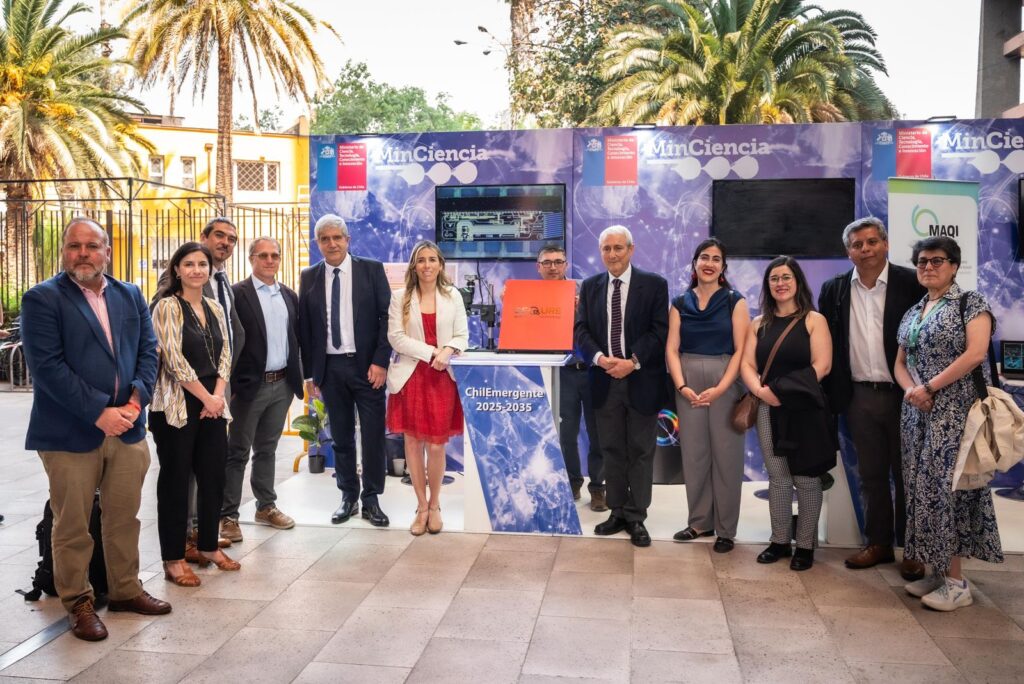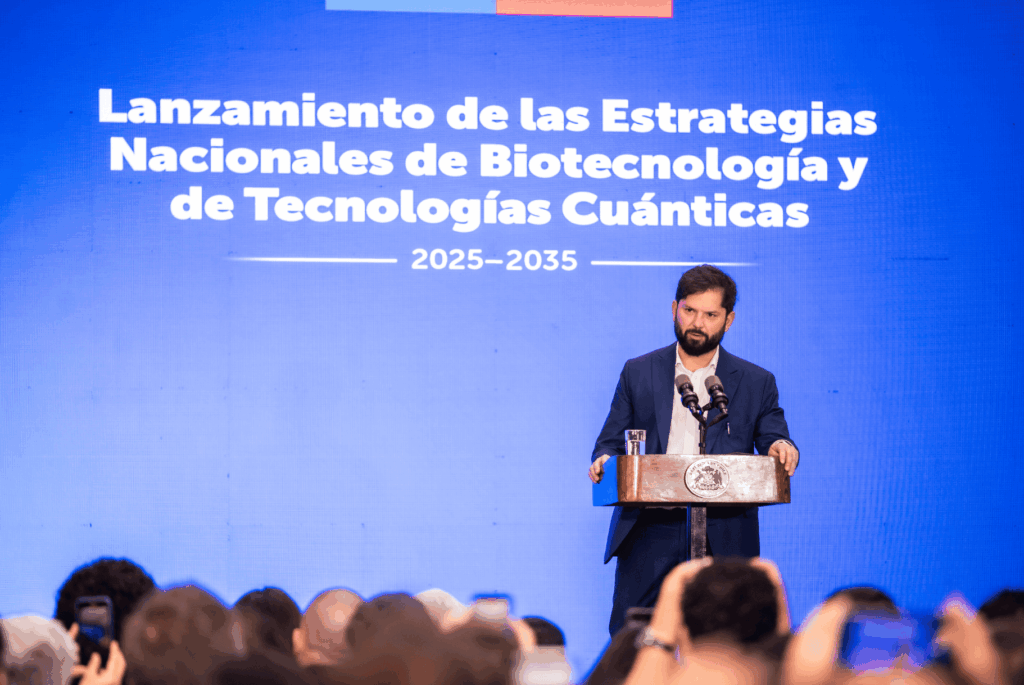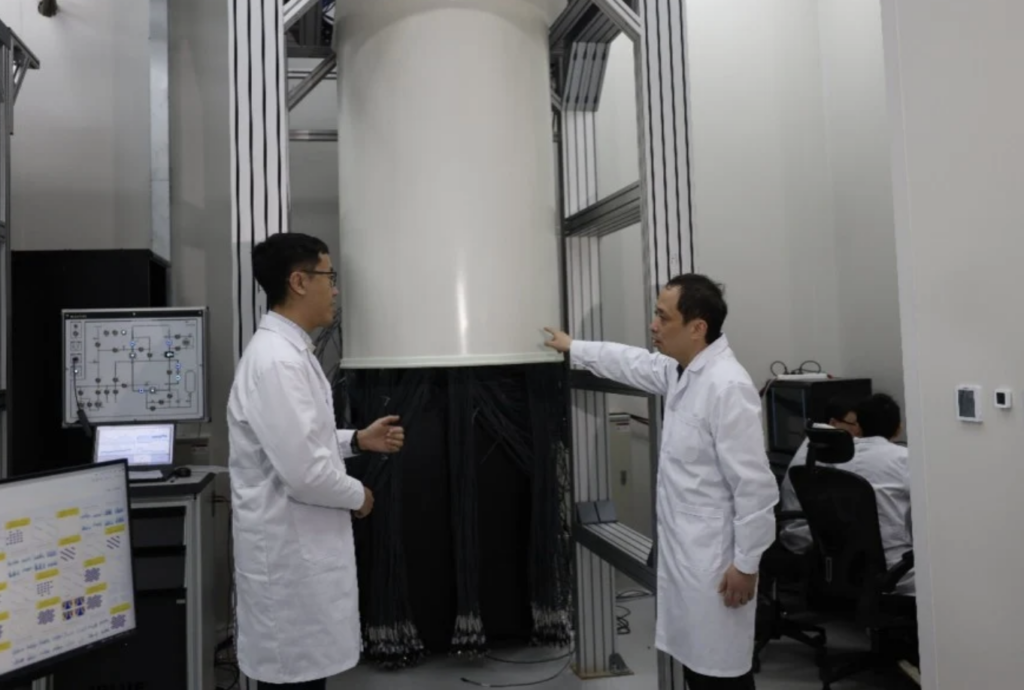Insider Brief
- Researchers at Aalto University and Lancaster University demonstrated that a continuous time crystal made of magnons can couple to a mechanical oscillator, forming a system that behaves like an optical cavity in optomechanics.
- The experiment confirmed a nonlinear, or quadratic, coupling between the time crystal and surface waves in superfluid helium-3, showing that their interaction mimics the dynamics of optomechanical systems used in precision physics.
- The findings suggest that time crystals could one day enhance quantum technologies by serving as long-lived memory elements or frequency references in quantum computers and sensing devices.
- A time crystal formed on top of a superfluid in ultracold conditions. (Mikko Raskinen/Aalto University.)
A team of physicists in Finland and the United Kingdom has shown that a time crystal — a strange, but perfectly natural form of matter that keeps a steady rhythm under quantum rules, even without a steady flow of external energy — can be coupled to a mechanical resonator, forming a system that behaves much like what scientists call an optical cavity in optomechanics — a setup similar to a hall of mirrors for quantum particles, where the motion of one part subtly changes the rhythm of another.”
The study, published in Nature Communications, marks a step toward merging the spontaneous rhythm of time crystals with precision control techniques used in quantum devices. For quantum computers, the study suggests it could lead to more stable and longer-lasting memory systems that preserve quantum information far beyond current limits. For quantum sensors, this could mean ultra-precise frequency references capable of detecting minute changes in time, motion, or fields with unprecedented sensitivity.
Researchers at Aalto University and Lancaster University created what’s known as a continuous time crystal (CTC) inside a sample of superfluid helium-3 cooled to a fraction of a millikelvin above absolute zero. In this extreme environment, magnetic quasiparticles called magnons — think of them as the magnetic equivalent of a sound wave — condensed into a single quantum state, collectively precessing in unison. This precession formed the time crystal, a state where the system’s properties repeat in time without external driving.

To explore how this self-sustaining rhythm interacts with the outside world, the team brought the time crystal into contact with a moving liquid surface that supported tiny gravity waves, or oscillations similar to miniature ripples on water. The surface acted as a mechanical resonator, while the time crystal served as a “quantum cavity.” When the two interacted, the researchers observed sidebands in the crystal’s frequency spectrum, a signature that the time crystal’s oscillations were being modulated by the mechanical motion.
This coupling mirrors the behavior of optical cavities used in optomechanics, where light bounces between mirrors –one fixed, one movable — and radiation pressure links the optical and mechanical motions. Here, the team replaced light with magnons and the movable mirror with a rippling surface of liquid helium.
“We showed that changes in the time crystal’s frequency are completely analogous to optomechanical phenomena widely known in physics,” said first author and Academy Research Fellow Jere Mäkinen in a statement. “These are the same phenomena that are used, for example, in detecting gravitational waves at the Laser Interferometer Gravitational-Wave Observatory in the U.S. By reducing the energy loss and increasing the frequency of that mechanical oscillator our setup could be optimized to reach down near the border of the quantum realm.”
Superfluid Trap
In the experiment, the time crystal was formed by trapping magnons in the superfluid using magnetic fields and spin-orbit forces. A short radio-frequency pulse injected magnons into the trap, after which they synchronized and began to precess at a steady frequency of about 833 kilohertz. These synchronized magnons — effectively the time crystal itself — were then positioned near the superfluid’s free surface, which could be gently tilted or oscillated using mechanical drives.
As the surface oscillated, it altered the local conditions of the magnetic trap, shifting the time crystal’s frequency in response. This produced a frequency modulation pattern nearly identical to that seen in cavity optomechanics, where an optical resonance is tuned by a moving mirror.
By systematically varying the amplitude of the surface motion, the researchers found that the time crystal’s frequency shifts were proportional to the square of the surface’s tilt angle, confirming a nonlinear or quadratic coupling. Confirming that the coupling was nonlinear is important because it showed that the time crystal’s response intensified faster than the motion driving it, a hallmark of true optomechanical behavior and a key step toward using such systems for quantum sensing and control.
They also could adjust the nature of the coupling — linear or quadratic — by fine-tuning the alignment of the apparatus.
Characterizing the Coupling
The interaction between the time crystal and the surface waves was analyzed in detail by sweeping the mechanical drive frequency and observing how the time crystal’s signal responded. The resonance occurred near 12.5 hertz, consistent with theoretical predictions for surface gravity waves in the helium container.
The team measured how the dissipation of the surface motion, or its energy loss, depended on temperature. The width of the resonance increased linearly with the number of quasiparticles in the superfluid, confirming the team’s expectations that the mechanical mode was indeed linked to the motion of the liquid’s surface. In effect, the time crystal became a probe — a quantum sensor — that could detect minute movements and energy flows in the liquid environment.
Interestingly, the coupling strength increased as the system’s temperature rose, due to the influence of superfluid flow on the order parameter of the trapping field. Near the surface, however, this effect was suppressed because boundary conditions prevented the order parameter from flexing freely.
Toward “Time Crystal Optomechanics”
The researchers propose the term “time crystal optomechanics” for this hybrid system, in which the time crystal’s intrinsic coherence interacts with mechanical motion. The result combines the sensitivity of optomechanics with the temporal order of a time crystal, potentially offering a new way to manipulate quantum systems.
The current setup operates far from the quantum regime of strong coupling. Reaching the quantum regime of strong coupling would mean the time crystal and the mechanical resonator influence each other so directly that their connection operates under the rules of quantum physics, not classical mechanics. However, the researchers suggest that this limitation is technical, not fundamental.
In future experiments, replacing the large liquid surface with nanoscale mechanical resonators could dramatically enhance the coupling strength. Lighter resonators vibrate at much higher frequencies and can achieve quality factors orders of magnitude greater than those of liquid waves, bringing the system closer to the quantum limit.
Such improvements could make it possible to control or even entangle mechanical and time-crystal states, paralleling recent successes in optical and microwave optomechanics. The researchers also speculate that similar coupling schemes could be developed using room-temperature materials such as yttrium iron garnet (YIG) films, which can host magnon-based time crystals.
Mäkinen said the long-lived nature of time crystals could have far-reaching implications.
“Time crystals last for orders of magnitude longer than the quantum systems currently used in quantum computing,” he said “The best-case scenario is that time crystals could power the memory systems of quantum computers to significantly improve them. They could also be used as frequency combs, which are employed in extremely high-sensitivity measurement devices as frequency references.”
However, the study is still proof of concept, but its significance is how it shows that a continuous time crystal can be coherently linked to an external mechanical system. This removes a long-standing experimental barrier, as previous realizations of time crystals were largely isolated from their surroundings.
The findings suggest that time crystals could be used in quantum sensing, frequency metrology, or precision spectroscopy. For example, the system’s frequency modulation behavior is similar to the generation of optical frequency combs, hinting that time crystals might one day serve as timing references or frequency stabilizers in quantum technologies.
However, as mentioned, the researchers note that the current coupling strength is weak. The frequency shift caused by the motion of a single quantum of the surface wave—a “ripplon”—is estimated to be far below detectable levels. The backreaction from the time crystal on the surface motion is also negligible, meaning that true bidirectional control has yet to be achieved.
Despite these limits, the experiment demonstrated exquisite sensitivity, operating in one of the coldest liquids ever studied. Even tiny dissipations were measurable through the temperature changes they produced, recorded using the time crystal itself as a thermometer.
The Road Ahead
According to the team, the next frontier will be designing lighter and faster mechanical resonators — perhaps nanomechanical beams or membranes — that can reach the quantum regime and strongly interact with magnonic time crystals. Theoretically, such systems could explore effects like the mechanical dynamical Casimir effect, where moving boundaries create particles from vacuum fluctuations.
Because the helium superfluid used here is also a topological material, future versions might help detect exotic quasiparticles such as Majorana fermions or serve as platforms for dark matter detection. In a broader sense, the work extends the idea of optomechanics into the time domain, replacing light with a quantum rhythm that never fades—at least until the last magnon decays.
According to the release, the researchers used the facilities of the Low Temperature Laboratory, which is part of OtaNano, the Finnish national research infrastructure for nano-, micro- and quantum technologies, and the calculational facilities of the Aalto Science-IT project.

















